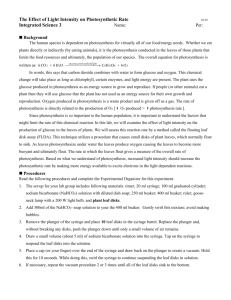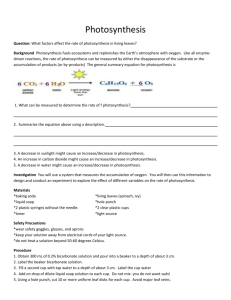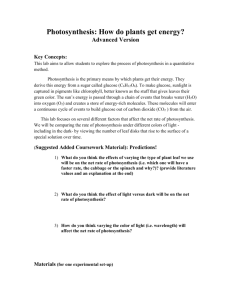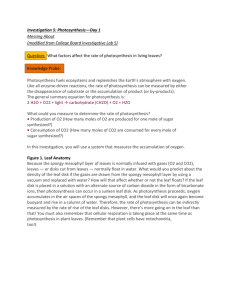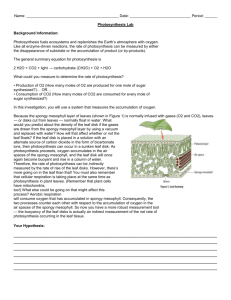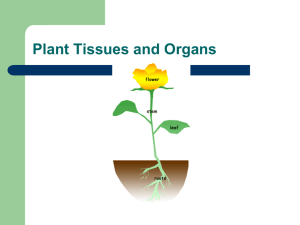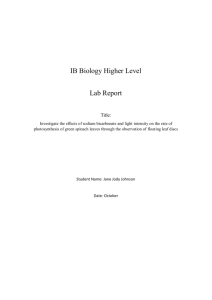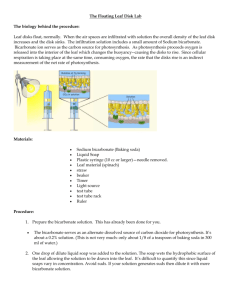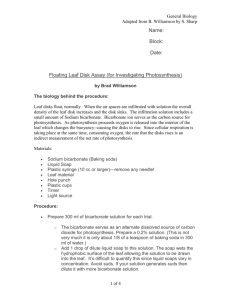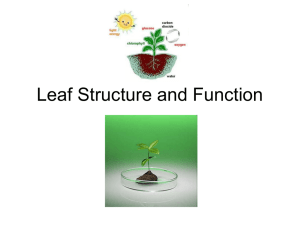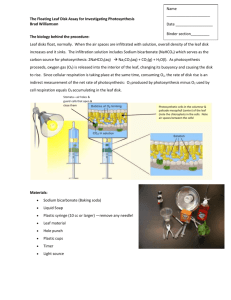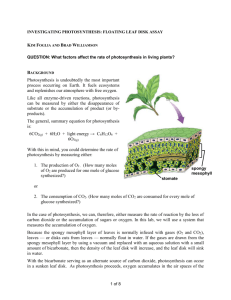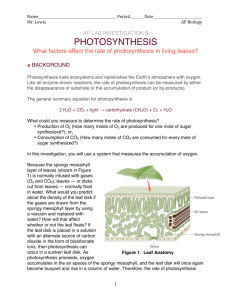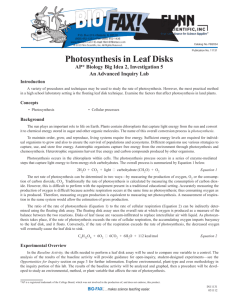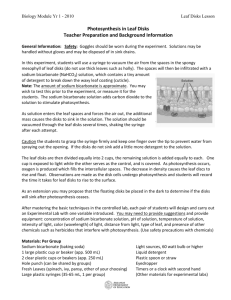photosynthesis lab
advertisement
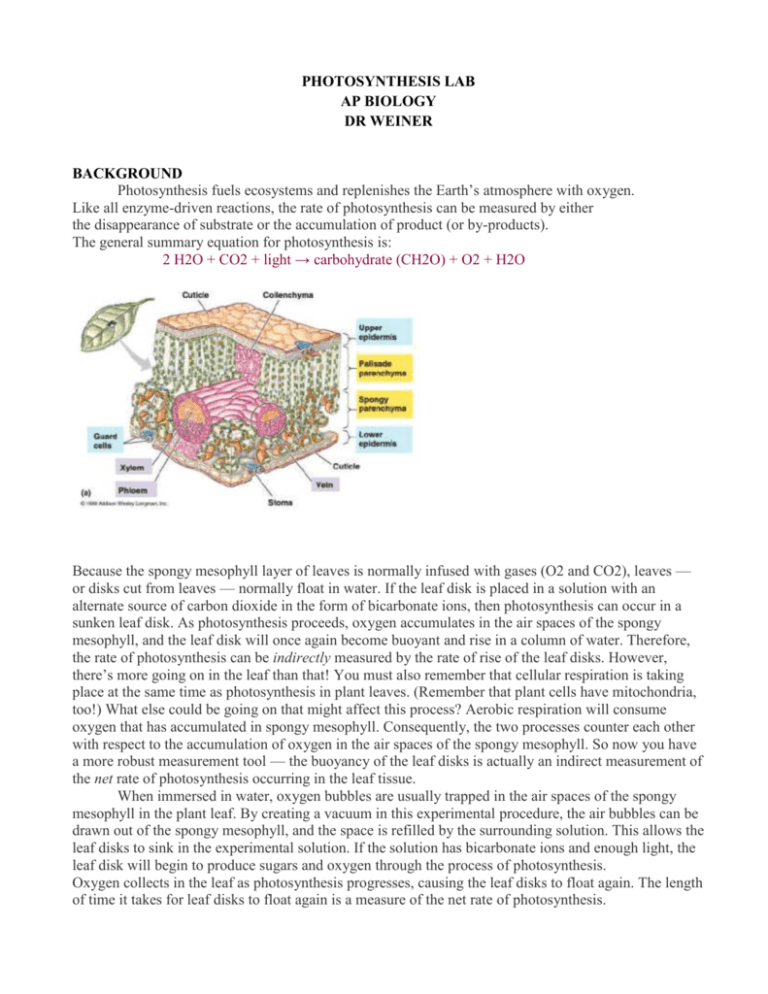
PHOTOSYNTHESIS LAB AP BIOLOGY DR WEINER BACKGROUND Photosynthesis fuels ecosystems and replenishes the Earth’s atmosphere with oxygen. Like all enzyme-driven reactions, the rate of photosynthesis can be measured by either the disappearance of substrate or the accumulation of product (or by-products). The general summary equation for photosynthesis is: 2 H2O + CO2 + light → carbohydrate (CH2O) + O2 + H2O Because the spongy mesophyll layer of leaves is normally infused with gases (O2 and CO2), leaves — or disks cut from leaves — normally float in water. If the leaf disk is placed in a solution with an alternate source of carbon dioxide in the form of bicarbonate ions, then photosynthesis can occur in a sunken leaf disk. As photosynthesis proceeds, oxygen accumulates in the air spaces of the spongy mesophyll, and the leaf disk will once again become buoyant and rise in a column of water. Therefore, the rate of photosynthesis can be indirectly measured by the rate of rise of the leaf disks. However, there’s more going on in the leaf than that! You must also remember that cellular respiration is taking place at the same time as photosynthesis in plant leaves. (Remember that plant cells have mitochondria, too!) What else could be going on that might affect this process? Aerobic respiration will consume oxygen that has accumulated in spongy mesophyll. Consequently, the two processes counter each other with respect to the accumulation of oxygen in the air spaces of the spongy mesophyll. So now you have a more robust measurement tool — the buoyancy of the leaf disks is actually an indirect measurement of the net rate of photosynthesis occurring in the leaf tissue. When immersed in water, oxygen bubbles are usually trapped in the air spaces of the spongy mesophyll in the plant leaf. By creating a vacuum in this experimental procedure, the air bubbles can be drawn out of the spongy mesophyll, and the space is refilled by the surrounding solution. This allows the leaf disks to sink in the experimental solution. If the solution has bicarbonate ions and enough light, the leaf disk will begin to produce sugars and oxygen through the process of photosynthesis. Oxygen collects in the leaf as photosynthesis progresses, causing the leaf disks to float again. The length of time it takes for leaf disks to float again is a measure of the net rate of photosynthesis. You will be testing the effect of one factor on the rate of photosynthesis. What is your hypothesis? Materials 0.2% Bicarbonate solution Dilute liquid soap (5 ml dish soap in 250 ml water) 3 30 ml syringes Leaves Hole punch 3 250 ml beakers Timer Light source Procedure 1. Label the 2 beakers with CO2 and1 beaker without CO2. 2. Pour about 150 ml of water into the without CO2 beaker and about 150 ml bicarbonate into the with CO2 beakers. 3. Add 2 to 3 drops of dish detergent to the beakers. Avoid generating suds. If suds form dilute it with more water or bicarbonate. The soap acts as a surfactant, wetting the hydrophobic waxy cuticle of the leaf allowing the water or bicarbonate to enter the leaf. 4. Using the hole punch, punch out 10 leaf disks for each cup. Avoid major leaf veins. 10 of the disks will come from a treated set of leaves. 5. To draw out the gases from the spongy mesophyll and replace it with liquid from either cup perform the following steps: Remove the plunger from the syringes, add 10 leaf discs to each, replace the plunger and push it all the way down till very little space is left. DO NOT CRUSH THE DISCS! Pull a small volume, about 5 ml of bicarbonate or water into the syringes. Do not let any air enter. Make sure you know which syringe has what solution. Tap the syringes to suspend the leaf disks. Make sure no air remains by holding the syringe with plunger facing down and pressing up till the air is gone. Create a vacuum in the syringe by holding your thumb over the narrow syringe opening and then pulling back on the plunger. Hold this for 10 seconds. During this holding time swirl the disks to suspend them. Release the plunger with your thumb still on the opening. If the plunger springs back you have created a vacuum and the solution will infiltrate the spongy mesophyll and the leaf disks will sink. If the plunger doesn’t spring back, you may need to repeat this a few times BUT NO MORE THAN 3. If the leaf disks don’t sink then add a few more drops of soap to the beakers and step 5. 6. Drop the disks and the solution into the appropriate beakers and place them in front of the light source 7. Every minute record the number of disks floating. Lab Writeup: Abstract Introduction including hypothesis Summary of what you did Table of time vs number of floating disks for all treatments Graph of time vs number of floating disks for all treatments Identify the ET50 (the time where 50% of the disks float) for all treatments Discuss results


